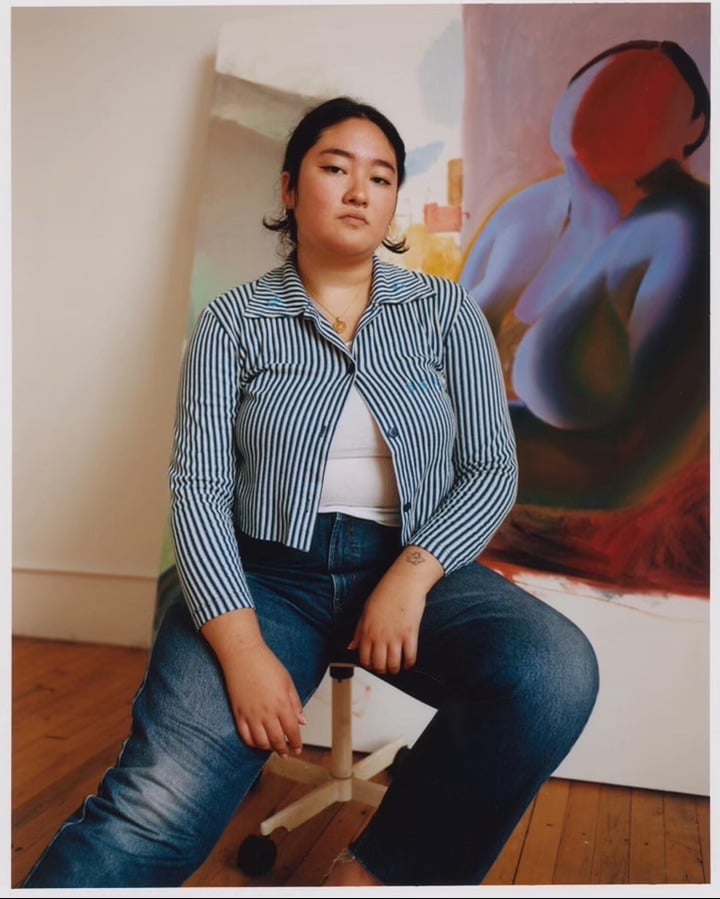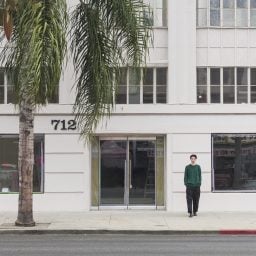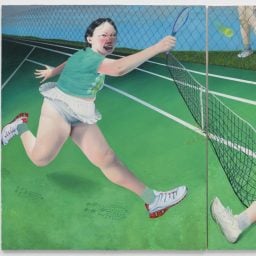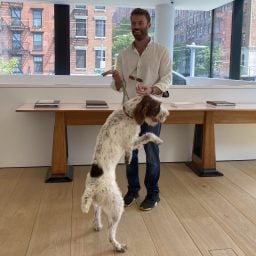Sasha Gordon is multiplying. In canvas after canvas, the young Brooklyn-based artist appears as doppelgängers of herself amid a wooded dreamworld. Here, her body twists and contorts, skin vulnerably exposed and glowing in fluorescent hues of purple, electric blue and bright yellow. This is “Hands of Others” at Jeffrey Deitch, Gordon’s first solo show in New York. A surrealist carnival, a house of painted mirrors, the exhibition brings together paintings made over the past year, and has the dizzying quality of a fever dream, with various versions of Gordon appearing by turns giddy and menacing.
Gordon (b. 1998), who graduated from the Rhode Island School of Design just last year, has been on a rapid ascent through the art world. Several years ago, the collector and art-world real-estate guru Jonathan Travis contacted Gordon via Instagram, inquiring about her work. Travis, who Gordon now considers a good friend, purchased a few pieces and soon after included her in a non-selling exhibition of works from his collection at Patrick Parrish Gallery. He later introduced her to the wunderkind L.A. gallerist Matthew Brown, who added Gordon to his roster in 2020 and inaugurated his second gallery space with a solo exhibition of her work.
Despite her head-spinning early success, Gordon seems grounded, offering wryly observant insights during our phone interview. With a hint of bemusement, she said she’d only recently set up her own studio in Brooklyn. Before that, she’d been working at her parents’ house in Somers, New York, a small bucolic town about an hour north of New York City. Brown had, in fact, made the trek to the suburbs to see her works in person for the first time. “I was still in college and he came to my childhood home. I had displayed everything in-house. Most of my work from high school is hung up already. My parents are really proud collectors,” she laughed. “It’s the Sasha museum.”
The daughter of a Polish-Jewish-American father and a Korean-born immigrant mother, Gordon describes the experience of growing up in the almost entirely white, heteronormative suburb as dissociative. “I became very aware of my body in space,” she said. At RISD, Gordon, who is queer, had only just found a diverse community of friends and professors who challenged her, but the pandemic brought her back home—albeit with a new mindset of painting, located not so much in the world around her as within herself.
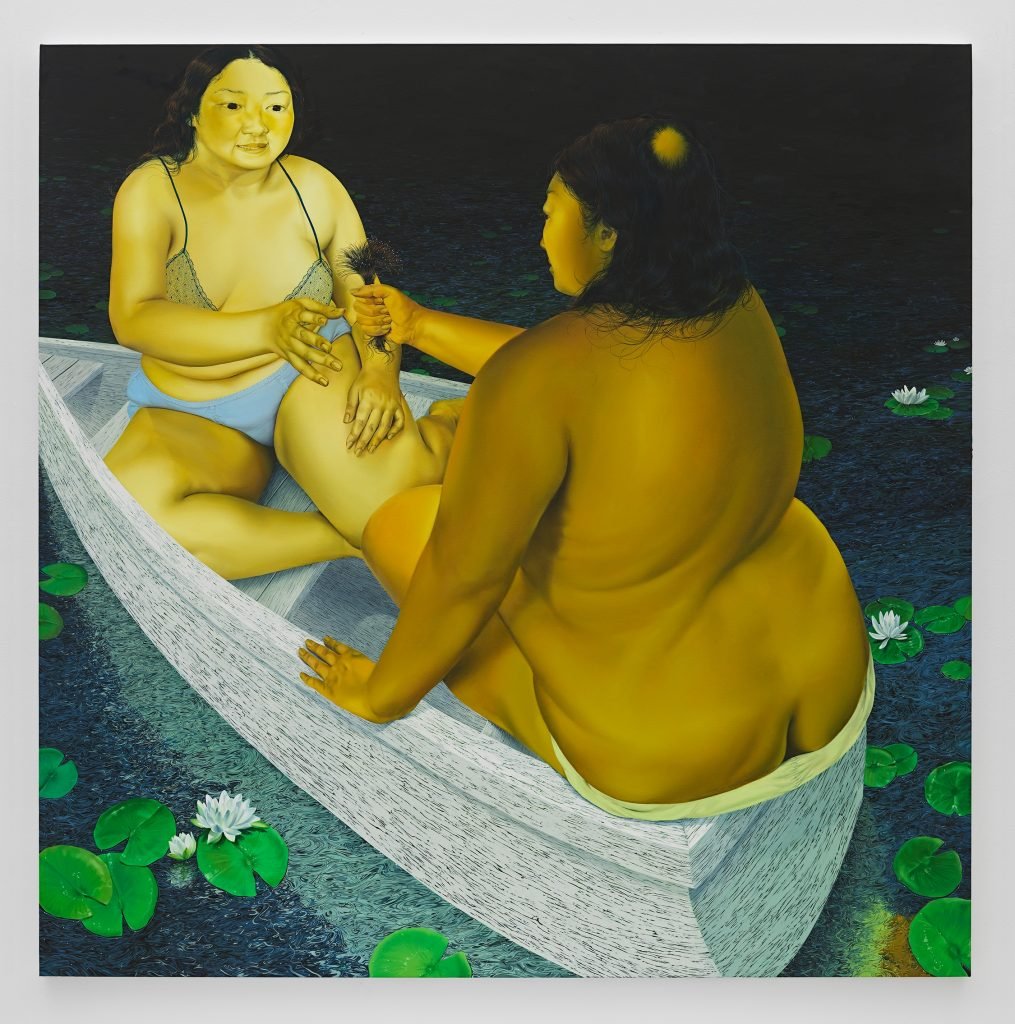
Sasha Gordon, Almost a Very Rare Thing (2022). Courtesy of Jeffrey Deitch.
All Eyes on Her
For Gordon, the exhibition’s title, “The Hands of Others,” has less to do with her figures’ actual hands (which do imbue the paintings with a sense of animation) and more with her awareness of an outside force that is constantly observing her figures—perhaps the eyes of society, or perhaps one’s sense of self-awareness. Hearing her descriptions of this invisible presence, the abstract phrases “had a hand in” and “hand of God” came to mind.
“This show in particular is more about this external force that is judging the figures in each piece,” she said. “This stems, I think, from my experiences growing up. I was forced to assimilate to this very white, heteronormative community and I became cautious of my surroundings, how to navigate them, and very aware of my body in space.”
While the scenes that play out in her paintings are not based on actual events, they emerge from experiences of her childhood. Over the past few years, Gordon’s language in describing her figures has shifted. “At first I said ‘Oh they’re not me. They’re just variations of myself.’ While I still think that’s true, they’re definitely all me. I don’t see myself as one person. I change depending on who I’m with or what the situation is or my mood and all these other aspects. Growing up, I guess I had a hard time seeing myself as a person. Painting myself so solidly is a way of making myself feel more permanent and present.”
Though this painted world occupied by variations of herself is in many regards a safe space for exploration, it is not free from conflict. “I used to say these works are in a kind of utopia in which all these versions of myself are living on a kind of commune, but I don’t want it to be too romanticized or perfect. I want them to have conflict amongst each other, showing the self-conflict I experience within my brain, my experiences of OCD, and my own awareness.”
In Almost A Very Rare Thing (2022), two Sashas, dressed only in their underwear, sit across from each other in a row boat. One offers the other a bouquet of pulled-out hair, while the other reaches to accept it with a look of concerned hesitation. We see on the first figure’s head a small bald patch, glowing amid her thick black hair. This unusual scene is Gordon’s allusion to her own experience of trichotillomania, a condition that involves compulsively pulling out one’s own hair. The painting, while disquieting, is also tender and unflinching.
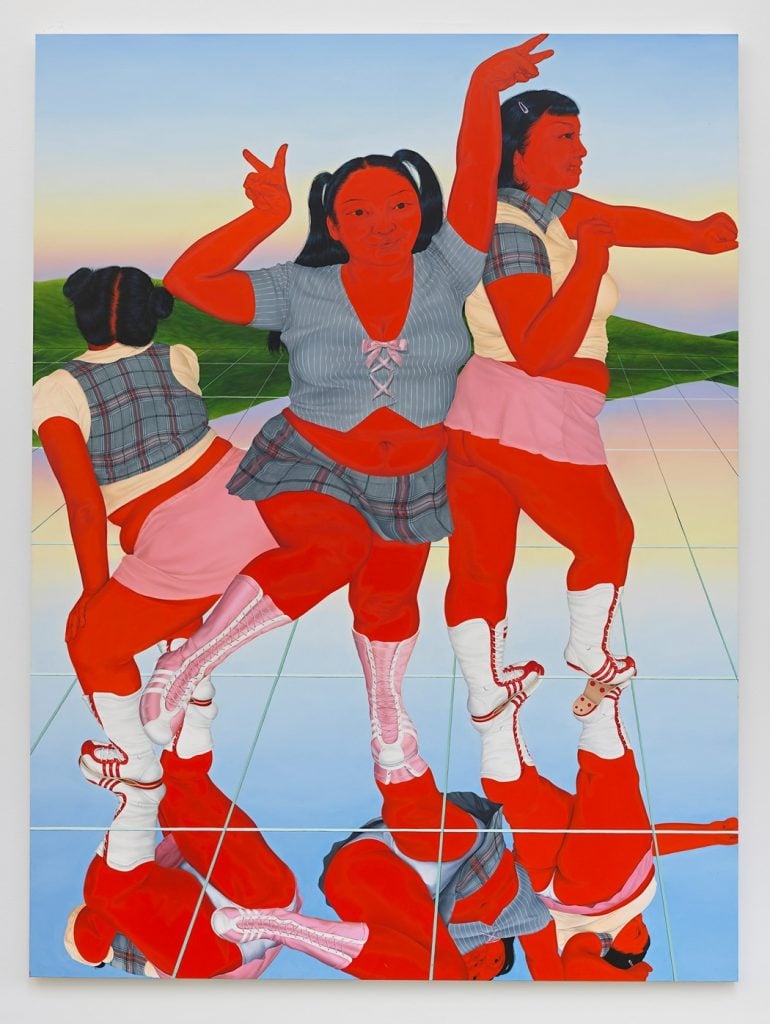
Sasha Gordon, In My Dreams, I Dance For You (2022). Courtesy of Jeffrey Deitch.
Fashioning Her Own World
When Gordon was a child, she spent her free time drawing fashion croakies, clothing designs, and patterns. “I didn’t realize at the time, but I was actually more interested in the croaky itself and not the fashion necessarily,” Gordon explained. But looking at her paintings, one can’t help but notice that her figures are often partially nude and the clothing they do wear is often ill-fitting, riding up, or falling down on their bodies.
“Having OCD, I’m very aware of how things fit on my body. When I was younger I was very sensitive to fabric and textures. I had to flip my socks inside out because for some reason the texture felt better and had to pull my underwear down a certain way. I think that’s why in Almost A Very Rare Thing the butt crack is out. It’s very particular. And I was also very picky with clothes because I didn’t have the standard skinny body type,” she reflected.
In the painting In My Dreams, I Dance For You (2022) a trio of Sashas appears like the Three Graces, dancing clad in itty-bitty Japanese schoolgirl uniforms. “This is the first time they’re really in costumes,” Gordon said. “I was basing the style off Gwen Stefani’s Harajuku Girls from the 2000s, who were her backup dancers and who always wore really crazy Harajuku outfits. Looking back, the whole setup was very racist, but I thought it would be funny to have the figures in costumes like that, all by themselves.”
Gordon’s earliest memories of fashion are of her mother, who the artist describes as a “wonderful person” who always encouraged her interests in the arts and signed her up for her first after-school arts program.
“Growing up, I would sometimes be a little embarrassed with my mom—she loves vintage and would wear these huge fur jackets and dresses from the ’50s and ’60s with really wide silhouettes on the bottom. I’d ask her if she could just wear jeans and a Michael Kors bag because that’s what all the other moms were wearing, while she was standing out,” Gordon says, laughing.
One painting in the show, Aquarius, shows a girl emerging from behind a beaded curation, her neck circled by the collar of a fur coat that Gordon says resembles the coats her mother often wore.
“Looking back, I didn’t realize it but my mom was the only Asian woman I could look up to. I wasn’t watching any media starring Asian women, I just had my mom,” she said.
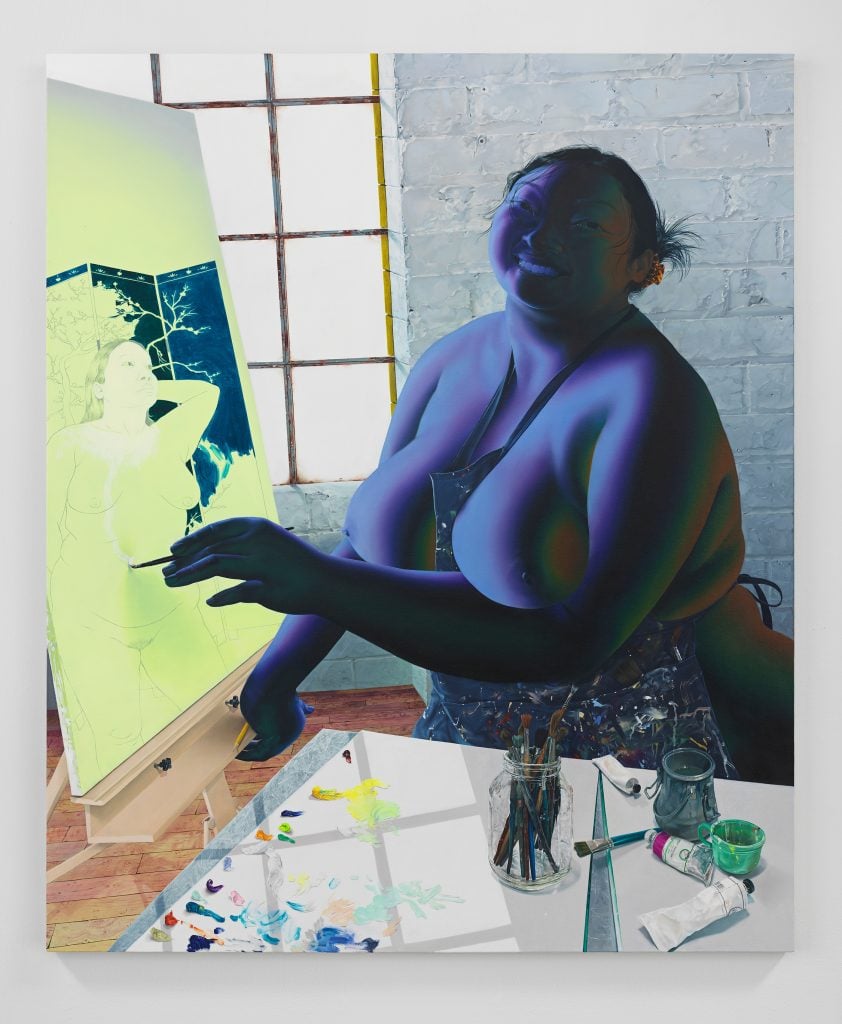
Sasha Gordon, My Friend Will Be Me (2022). Courtesy of Jeffrey Deitch.
The Mood Ring
Gordon considers the last few months of work leading up to the show at Deitch as some of the most intensive and decisive in her career so far. “I really had to put my head down and work,” she said, “I had to make decisions.” In addition to her solo show, Gordon also has work featured in the gallery’s concurrent exhibition “Wonder Women,” curated by Kathy Huang.
Now, emerging post-exhibition, Gordon finds herself with a studio in East Williamsburg and a world lifted largely from health restrictions that had kept her indoors for much of the past two years. While the world is seemingly at her fingertips, Gordon is wary of the current market frenzy for emerging artists. “The emerging artist thing is popping off at the moment which is good and bad. Just because you’re young doesn’t mean you necessarily have more to say or anything better. People have been concerned about my age in the past and that can be stressful because you want to be taken seriously,” she said. “I’ve also been painting since the third grade.”
Gordon is more focused on the future of her works than her market and acknowledges the influences of artists including Nicole Eisenman, Chinese avant-garde artist Wei Dong, and Lisa Yuskavage, who she says is her go-to if she’s stuck on colors. Recently, she’s also been thinking about the work of the 19th-century Swiss painter Felix Vallotton, whose “landscapes look like sleeping people.”
Conversations about colors light her up. Gordon describes a 2019 trip to Rome as transforming both her sense of scale and her understanding of tones. “I realized the sky could be green,” she said, adding that she believes there is more to explore within her sometimes dazzling, sometimes jarring, and always unnatural use of color.
“Growing up, I had a hard time expressing emotions and talking things through. I had started making these portraits of really emotional faces, laughing or crying, but changing the color of skin. That color can be another form of expression, the temperature or mood ring of a person no matter what their face appears to be saying,” she said.
As for the color of her current moment? She says we have to wait and see.
“Sasha Gordon: Hands of Others” is on view at Jeffrey Deitch, New York, through this Saturday, June 25.
